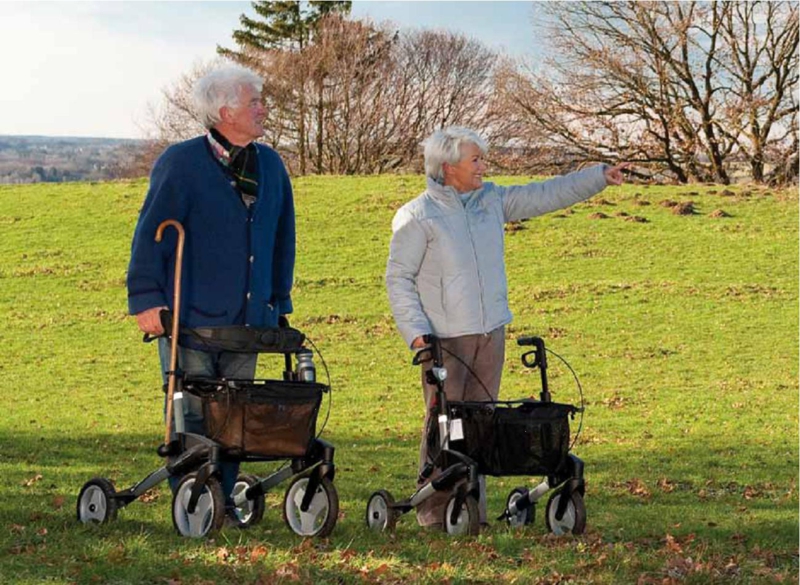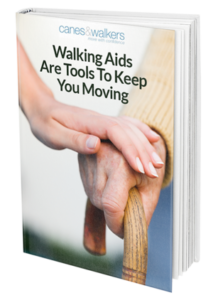We never really realize how much we take our mobility for granted until we are faced with mobility issues. Whether you are suffering from an illness or injury that is causing you not be able to get around like you’d want, or maybe you’ve reached an age where you have difficulty standing and walking on your own.
In these situations, it’s not hard to get frustrated and feel like you’re trapped because you now need someone’s help to get from one place or another.

That doesn’t have to be the case anymore. With the help of walking aids, you’ll be able to reclaim your independence and zip around whenever and wherever you’d like—without the help of someone else.
In this guide, we are going to talk about the different types of walking aids, who can benefit from them, and much more. We’ve got a lot of ground to cover, so let’s get started!
What Is A Walking Aid
A walking aid (sometimes called a mobility aid) is a device that has been designed to help the user improve their mobility. There are several types of walking aids that we will cover in this article, which includes:
- Canes
- Crutches
- Walkers
- Rollators
- Wheelchairs
Why Use A Walking Aid
Walking aids will serve one of two purposes: as a tool to help you recover from an injury or a surgical procedure, or it will be a tool that will be used for the long term due to a decrease in mobility. These tools can are useful for the following reasons:
- Improving one’s stability. The walking aid will give the user extra support while walking because the device will create a wider, more stable center of gravity.
- Reduces impact on the lower body. When we walk, we are putting a lot of pressure on our legs and feet. A walking aid can help redirect some of that pressure through the arms and the aid itself.
- Creating movement. By using a walking aid and the muscles in your arms, you are relieving the muscles and joints in spine, pelvis, and legs by creating dynamic forces as you walk.
During the rehabilitation process, you will gradually progress from needing assistance to get around and will work up to being able to walk unassisted. In some cases, you will start off with one type of walking aid before you will be upgraded to the next.
For example, you may start off with a walker and you could be upgraded to a cane before being able to walk completely unassisted.
In those situations where recovery isn’t possible, or you’ve suffered an illness or condition that causes your legs to be permanently affected, the use of these tools will be a long-term situation.
Who Can Benefit From Using Walking Aids
A walking aid is useful for those who have undergone a surgical procedure on their lower extremities like the foot, ankle, leg, knee, or even hip. Sometimes when people suffer from a stroke, they may also require the assistance of a walking aid because their balance was affected.
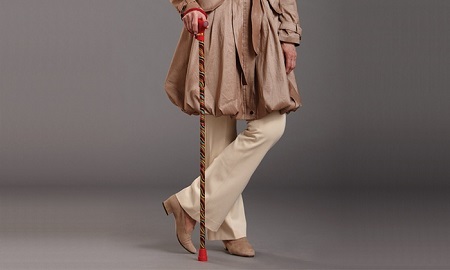
Seniors are also great candidates for using a walking aid. As we get older, we may not be able to perform everyday functions that we used to, causing us to become more dependent on our loved ones for assistance. However, with the help of a walking aid, you’ll be able to get around a little easier.
These aids will encourage physical activity, which is so important as we age, as it improves your overall health, reduces risk of heart disease, type 2 diabetes, and certain cancers.
Types Of Walking Aids
If you’ve noticed that you aren’t able to move around like you used to, or if you’ve endured some kind of injury where you aren’t able to walk like you used to, you might want to consider purchasing a walking aid. These devices will help get around like your used to.
As we previously mentioned, there are five types of mobility aids that you could choose from:
- Canes
- Crutches
- Walkers
- Rollators
- Wheelchairs
To decide which of these tools will be best for your needs, we do recommend that you consult with your primary care physician for their recommendations. With that said, let’s take a closer look at each of these tools.
Canes
A cane or a walking stick might all that you need. These devices are designed to provide you with a little extra stability if you are having problems maintaining balance. They can make the person feel safer as they walk, but they can also serve as an indicator to others that you have trouble getting around.

Types Of Canes
There are several different types of walking canes that a person can choose from:
- Single Point Canes: These canes have a single support point and they are typically the most common type of cane available on the market today.
- Multiple Point Canes: These canes have multiple points of support, whether it is a tripod cane or a quad cane. These devices will have three or four points that are in contact with the ground and the will provide you with more support than a single point cane. It is worth noting that if you are going to go with a four point cane (quad cane), you can choose between a unit with a wide base, or a small base. The large base cane is ideal for those who need extra stability, as there is a wider center of gravity.
- Folding Canes: These canes are designed with portability and storage in mind. Typically they will fold at three or four points, and they are also adjustable. These canes are ideal for those who travel frequently and don’t want to be bothered with a cumbersome, fixed cane.
- Seat Canes: These sturdy canes have a fold down seat attached that the user can use when they need a break.
Sizes And Styles
As you shop for a walking cane, you will want to take into consideration the size of the cane. Most medical grade canes are going to be adjustable so that you can find the perfect height for your needs. By choosing an incorrect size, you could put yourself in danger of muscle strain, cramps, and other discomforts.
To find the perfect size can for your needs, follow these steps:
- Wear the shoes that you typically wear and stand straight on a level surface.
- Leave your arms hang at your sides.
- Measure from the floor up to the bottom crease of your wrist. The cane you choose should have the same dimensions as this measurement.
There are a variety of styles of walking canes available on the market. Most of these canes are made from one of three materials:
- Wood – lightweight, not very sturdy, but decorative
- Aluminum – usually adjustable, lightweight, sturdier than wood, a variety of colors and designs.
- Steel – usually adjustable, heavier, and much more sturdy
Crutches
Crutches are often prescribed by a medical professional because you’ve suffered an injury or are recovering from a surgery in your lower extremity. These tools are usually made from aluminum and have padding on the hand grip.

These aids are designed to be used in a pair and only for temporary uses. Unfortunately, because these do need to be used as a pair, you’re going to need some coordination to be able to use these tools correctly.
There are three types of crutches your doctor may recommend:
- Elbow – Most common type of crutch. The user will slip your arm through a cuff that reaches just above your elbow, and you’ll grip the handle.
- Underarm – Another common type of crutch. The top of the crutch will rest in the armpit, but be sure not to lean on the pad because it could stop the arm’s blood flow and blood pressure, and even cause damage to the nerves in your armpit.
- Forearm crutches with gutter rest – These crutches are designed for people who have pains in their hands and need to bear weight through their forearms.
Walkers
A walker is a device that is going to provide you the most support over the previous devices. These devices are U-shaped with four legs and you can stand inside the walker as you move.

A walker is able to transfer up to 64% of a person’s body weight through your arms and the frame of the walker, making it much easier for a person to move around if they have problems with their legs.
Types Of Walkers
There are three types of walkers:
- Basic: A basic walker is one that doesn’t have any wheels. They are available in both a heavy duty form and lightweight. These walkers do not have wheels, which will require the user to lift the walker as you move. These tend to be the most stable because you don’t have to worry about the wheels rolling out from under you.
- Wheeled: These walkers are much like the basic unit, except the front two legs have wheels on them and the back legs will have smooth gliders, which helps to make the walker move much easier across surfaces. These wheels are fixed, as they can only go forward and backward. Because they do not swivel, you will have to lift the walker when you need to turn.
- Rollators: Rollators are walkers with four wheels. We’ll go into greater detail about these devices in the next section.
Size And Styles
As you are looking at walkers, you’ll notice that they generally have the same shape and style. However, it is important that you consider the width and the height of your walker.
Most bathroom doors are only 22 inches wide, while some walkers can be up to 24 inches wide. You will want to measure the size of your doorways before purchasing a walker.
Also, it is important that you take into consideration the height of the walker. You don’t want a walker that is too short because you’ll be hunched over and that’ll cause back pain.
Ideally, you will want a walker that is adjustable so you can get the perfect fit. To figure out the perfect height, you can follow the same measuring tips used to find the right cane height.
Rollators
A rollator works much like a walker, except it has three or four wheels. These tools were designed for indoor and outdoor use, but they can also navigate uneven surfaces.
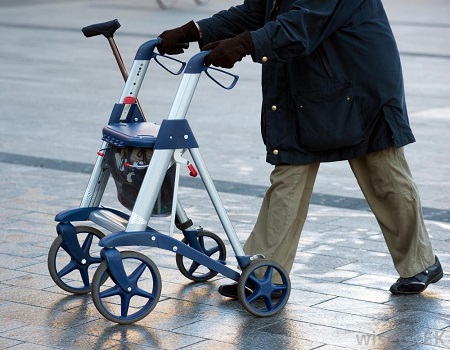
These devices will often have a seat and storage compartment underneath the seat so you can keep your valuables within arm’s reach (keep in mind, a three wheeled rollator usually does not have a seat).
People often prefer a rollator because you’ll have optimal freedom to come and go as you please, but you can also go greater distances, and if you get tired, you can stop and take a break, thanks to the seat.
Rollators will usually have a braking mechanism on the handles, which is an important safety feature, especially if you intend on sitting down. The brakes will prevent the rollator from rolling out from under you as you go to sit, but the brakes can also stop the rollator from getting away from you if you are going downhill.
Wheelchairs
For those who cannot move around on their own, a wheel chair is the go to choice for those who cannot use one or both of their legs.
There are several types of wheelchairs available, and you should consult your doctor to find out which one will suit your needs the best.

- Standard: These wheelchairs are good for those who aren’t going to be in the chair all day. These chairs can be self-propelled and pushed from behind.
- Transport: These chairs require someone to push from behind.
- Lightweight: These are ideal for those who will be using them frequently and have the arm strength to propel themselves.
- Rigid Ultra-Light: These wheelchairs are designed for the athlete who wants to make the most of their performance.
- Tilt in Space: These chairs are designed for people who will be in the chair for long periods of time. They tilt back to reduce pressure points and prevent sores from developing on the user’s body.
- Reclining: These chairs are designed for someone to recline at various degrees comfortably. They are usually used by people who suffer from severe hip extension contractures, orthostatic hypotension, and redistributing pressure.
How To Adjust To Using A Walking Aid
Getting used to using a walking aid isn’t going to happen overnight—it will take a bit of practice. We have some tips that will help you use your walking aid comfortably and safely:
Walking Stick/Cane
- Stand up straight, with the top of your cane reaching the crease of your wrist.
- Your elbow should be bent slightly while holding the cane’s handle.
- Hold your cane on the opposite side that needs support (injured left leg, hold the cane with the right hand).
- As you walk, your can should be one step ahead of the injured leg. Step off with your injured leg and follow up with the good leg. To climb stairs, your cane should be in the opposite hand of your injured leg. Use your free hand to grip the railing and step up with your good leg first.
- To go down stairs, your cane should be the first thing to touch the step, then your injured leg, then finally the good leg. Your good leg should be carrying your weight.
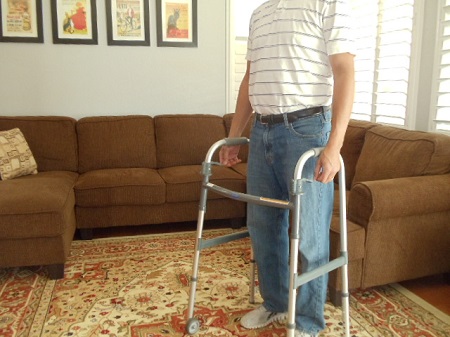
Walkers/Rollators
- Stand up straight and the top of your walker should be at your wrist.
- Elbows slightly bent, grip the handles of your walker.
- Keep your back straight while using your device—never hunch over!
- Make sure the rubber tips of the walker aren’t damaged because if they are worn or uneven, you may have trouble with traction.
- As you walk with your walker, you should keep the walker one step ahead, with all four legs planted on the ground. Keep both hands on the walker as you move. You should be in the middle of the walker’s opening.
- You do not want to walk outside of it. It is important that while you are moving, you push down in the hands when moving your injured leg.
- When you are going to sit, back up to the chair until the backs of your leg are against the seat. You will want to move your hands to the arms of the chair and gently lower yourself into the seat.
- When standing, you should put one hand on the arms of the chair and then hold onto the walkers hand grips. You never want to tilt the walker toward you as you stand. Also, never use a walker to go up or down stairs or escalators.
Which Is Better, Cane Or Walker
Both tools have their own purposes. A cane is best suited for those who do not have a lot of trouble with their balance or any injuries. A walker is best suited for those who have balance troubles and/or an injury.
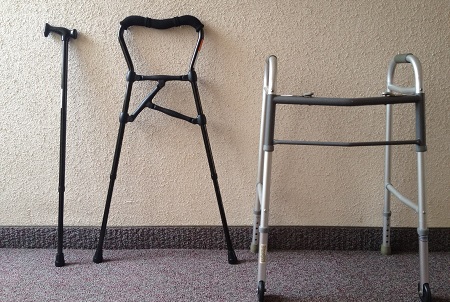
The tool you choose should be reflective of your specific needs. Once again, it’s always a good idea to consult your doctor before purchasing one of these tools.
Will Insurance Cover A Walking Aid
We’d like to say that yes, health insurance will cover your walking aid. However, it isn’t as simple as that because we all don’t have the same insurance. Some companies will cover them and others will not.
Generally speaking, if you have Medicare Part B, your doctor can prescribe a walking aid for you. Your doctor will have to document why you need the tool. The prescription will then need to be received by the supplier before Medicare is billed.
With this insurance coverage, you will only be expected to pay 20% plus any remaining part of your deductible. Medicare Part B will cover 50% of the cost of your cane or walker.
If you do not have Medicare or if you want to know for certain if your insurance will cover the equipment, we recommend calling your insurance provider and checking with them to make sure of the prices and requirements.
Conclusion
Discovering that you are having troubles walking can be a devastating blow to anyone. It can be incredibly frustrating when you’ve lived an active life and all of a sudden, you’re unable to do the things you used to do because of an illness, injury, or even because of old age.
Fortunately, you don’t have to live your life relying on others to help you get around, or worse, being stuck inside. With the help of walking aids like canes, walkers, or rollators, you have the opportunity to regain some of your independence and enjoy life again.

The key to regaining your independence is choosing the right walking aid for your needs. You don’t want to run out and buy a cane when you really should purchase a walker or a rollator. The best way to discover which tool will work best for you, you should always consult your doctor first.
With their help, they can recommend the best option, but they can also write you a prescription for one of these devices. If your insurance covers walking aids, you may be able to get your aid at minimal to no cost to you.
However, if you are buying these things for a loved one to replace an old walking aid, you can check out our cane buying guide or our walker/rollator buying guide for our top three choices for each.
Leave us a comment below if you have any questions or concerns. Or, leave a comment and tell us which walking aid you like best and why! We’d love to hear from you!

